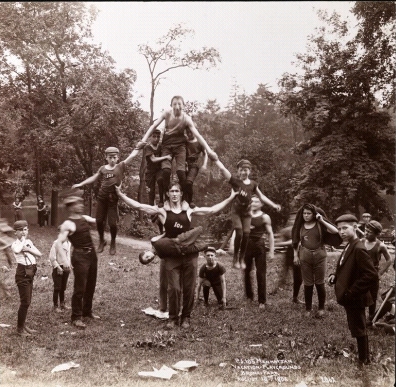
THE PARKCENTRIC: PHOTOS FROM THE MUSEUM OF THE CITY OF NEW YORK, 1890-1940
Exhibition on view June 14–August 30, at Central Park.
Featuring 68 photographs illustrating 24 parks, Parkcentric: Photographs from the Museum of the City of New York, 1890-1940, celebrates two great civic institutions—the New York City parks system and the Museum of the City of New York. The Museum, originally housed at Gracie Mansion, and since 1932 at Fifth Avenue and 103rd Street, celebrates and interprets the city, educating the public about its distinctive character. Its photographic collection alone has more than 300,000 images, which provide an extraordinary portal on the past, helping to define New Yorkers’ self-image.
“The Arsenal Gallery is pleased to host Parkcentric: Photographs from the Museum of the City of New York, 1890 – 1940,” said Parks Commissioner Adrian Benepe. “The visual beauty of this photographic collection will allow viewers an insight at the growth and modernization of the parks system. We are proud to showcase these works of art that help connect the past and present New York City. I am grateful to the Museum of the City of New York for lending us this collection, which will allow New Yorkers the unique opportunity to view our parks as they appeared in prior generations, and to Jonathan Kuhn, whose discerning eye and encyclopedic knowledge of the NYC park system and its history make this show so rich and multilayered.”
The pictures in this show focus on a critical period in the parks system—from the social reform movement to the WPA-era on the cusp of World War II. They have been selected both for their visual power and for their revealing depictions of the beauty, variety, and vitality of the City’s parks. This was a time of startling growth and modernization. The population soared from 2.5 to 7.5 million people, and the City became the metropolis that remains surprisingly recognizable.
The photographers represented here bore witness to this ascendant city, and the complex interplay of its rapidly expanding population and parks (today comprising nearly 15% of New York City). The burgeoning skyline of modern skyscrapers framed older parks, including City Hall, Madison Square, and Central Park, helping define these critical oases in increasingly dense neighborhoods. Social service groups and the City responded to the immense needs created by the waves of new immigrants. The Parks Department created new parks, built its first playgrounds, and launched its recreation division to promote health and citizenship.
From the outset, the Museum of the City of New York supported talented photographers in their zeal to document the City’s evolution, mounting early solo shows by Berenice Abbott, Samuel Gottscho, and John Albok among others. The self-taught Gottscho produced images of striking formal precision, whether his subject was architecture or nature. Abbott, influenced by Eugene Atget and Man Ray in Paris, caught the tension between old and new with honesty and clarity.
Later, the Museum acquired the collection of the Byron Company, New York City’s preeminent commercial photo studio, as well as that of Danish-born Jacob Riis, the pioneering photojournalist and social documentarian. Some of the photographers in the Museum’s collection—such as Robert Bracklow and Charles Von Urban—seemed on a personal quest to preserve, through the camera’s lens, a world that was rapidly vanishing, while others such as Jessie Tarbox Beals and Robert Perry turned their camera upon their neighborhoods, capturing the social disparities in their midst.
Unlike the often staged compositions of official pictures, these have an informality that captures the textures of New York life—ecstatic children at play, a solitary woodland retreat, the tortured social etiquette of Victorian-era bathers, an automobile overtaking horse and buggy, the contrasting fortunes of the indigent and the gentry. As the photographers shown here demonstrate with empathy, insight and artistry, though times may change, the parks remain central to the life of the city.
The exhibition is curated by Jonathan Kuhn, Parks’ Director of Art & Antiquities.
The Arsenal Gallery is dedicated to examining themes of nature, urban space, wildlife, New York City parks and park history. It is located on the 3rd Floor of the Arsenal at 64th Street and Fifth Avenue in Central Park. The gallery is open Monday through Friday from 9:00 a.m. to 5:00 p.m. (closed July 4). Admission is free.
Founded in 1923 as a private, nonprofit corporation, The Museum of the City of New York celebrates and interprets the city, educating the public about its distinctive character, especially its heritage of diversity, opportunity, and perpetual transformation. The Museum connects the past, present, and future of New York City, and serves the people of the city as well as visitors from around the world through exhibitions, school and public programs, publications, and collections.
IMAGE CREDIT: Public School 105 (Manhattan) Vacation Playground, Bronx Park, the Bronx, 1902, Jacob A. Riis, Collection of Museum of the City Of New York (90.13.3.1666)